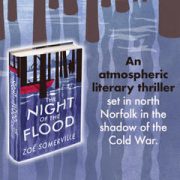The Process Of Writing THE NIGHT OF THE FLOOD

photographed by Beata Cosgrove
The process of writing The Night of the Flood
I wanted to describe the process of writing my debut novel in a way that would be helpful to other writers so I thought I would tell it as a narrative. This story, like most classic tales, is in three acts.
Act One. Beginning.
It was my childhood dream to be a published author, but as I grew up, I had no confidence in my writing. I wrote throughout adulthood but it wasn’t until I was 39, in 2015, that I began writing The Night of the Flood. By this time I had already spent about four years writing another novel which was put in the metaphorical drawer.
I had worked as a teacher part-time while my children were small and wrote in snatched moments on the kitchen table or in cafés. But when my mother-in-law offered to help me pay for a MA in creative writing at Bath Spa University for my 40th birthday, it seemed like a real chance to see if I could write a publishable novel.
The first time I received negative feedback for my writing, I cried in the car on the way home. But the camaraderie of the other students, and the dopamine rush of praise, kept me going. There are many ways to become a writer – but I think doing some kind of course is extremely helpful in carving out the time to experiment and to write. It signals to family and friends that you take it seriously. The Masters was only the beginning for me, but it was a crucial step.
Act Two. The Middle
This section could also be called A Series of Lessons and Errors.
The first lesson was about how to tell the story. I already had the beginnings of the novel – the characters, the backdrop of the flood, but at first I was going to write a dual narrative where the two main characters, Arthur and Verity, were looking back at their youth. Early on in the course, I began researching the 1953 flood. This soon became the focus for the novel and the turning point of their young lives.
Initially, I was going to hone in on the night itself and tell the story of what happened to each of the characters, with their versions overlapping. I was still experimenting, writing from different characters’ perspectives, in alternative tenses and person. However, as I wrote chunks of the narrative and submitted them for feedback, I quickly settled on the past tense close third person.
The second lesson was what story to tell. It became clear that the 1950s element was stronger. And I received a crucial piece of advice from Tessa Hadley: to extend the 1950s section to the summer before the flood so that readers could get to know the characters – their feelings, their hopes and dreams – before the catastrophe of the flood overwhelmed them. It was a key insight into the importance of structure.
By the time it came to submitting the 25,000 words of my dissertation, I decided to concentrate on the first section of the novel. Then I only had the rest to write! I spent the next six months finishing the novel in time for the terrifying ‘Meet the Agents’ event the course organises in London the following May. At this stage, it still contained a section in the present day.
It was at this point that I made my first error. Before the event, agents are sent a sample of everyone’s work in an anthology. We all then gathered at Waterstones in Piccadilly. I was sweaty, nervous and excited. But by the end of the evening, I had some interest from agents and in my excitement, I sent off the novel.
In many ways I was extremely lucky – most of the agents got back to me – some with standard rejections, but some asked for the full manuscript, which is a good sign. However, eventually all the agents replied and none offered representation. It was a blow. Yet I was lucky again – a few of them offered feedback, some of it extremely helpful, and some asked me to get back to them if I wrote another novel – or another version of this one. After a few days of feeling sorry for myself I realised what this meant: that the book had some merit but I needed to re-write it. I had, I now realise, sent off my first draft.
Later that year, I submitted again. Mistake number two. I thought I had made some big changes. I’d got rid of the present day section, I’d focused more on the character of Verity, I’d even changed the title of the book to reflect its change of focus. But when the responses came back the second time, the same kind of thing kept coming up: that the story didn’t have enough impetus.
This was the lowest point. I felt that I’d burned my bridges now. I tried to write a different novel. But I couldn’t let go of this one. I felt that I had something worthwhile – some really experienced, wonderful agents had told me that. But it was often hard to keep going.
In the end, I needed to learn more about the craft of writing. It took key insights from other readers to help me gain the confidence to approach agents for a third time: I needed to work on the plot and strengthen the story arcs of all the characters. By now it was 2018. This was what I worked on for the rest of the year. I had to re-calibrate the structure to give it the momentum to take the reader through to the end.
Act Three. The ending
Finally, in early 2019 I found my agent. The novel needed two rounds of further editing. This involved digging further into each of the characters’ motivations and behaviour; building up tension at critical points and deepening the historical research. Crucially, it was my agent who also suggested the final title: The Night of the Flood. By summer 2019, we were ready to submit to publishers.
After a nail-biting August, on the bank holiday 2019 I was driving to Norfolk with my children when my agent called with the news that I had a deal!
The final edits with my actual editor were the most enjoyable of them all. At this point, my editor asked me to work further on Verity and Arthur, clarify some of the spy subplot and tidy up the structure. But the most painful, difficult editing had already been done. The synergy with both my agent and editor is what took the novel through to publication: they didn’t want to change the story; they wanted to make it the best it could be.
This particular story has a happy ending, but I’m now working with my editor on my second novel and that is another story entirely.
—
Zoë Somerville is a writer and English teacher. Having lived all over the world – Japan, France, Washington – she now lives in Bath with her family. After completing a creative writing MA at Bath Spa, Zoe started writing her debut novel, which is inspired by her home county, Norfolk, and the devastating North Sea flood of the 1950s.
THE NIGHT OF THE FLOOD
 Summer, 1952. Verity Frost, stranded on her family farm on the Norfolk coast, is caught between two worlds: the devotion of her childhood friend Arthur, just returned from National Service, and a strange new desire to escape it all. Arthur longs to escape too, but only with Verity by his side.
Summer, 1952. Verity Frost, stranded on her family farm on the Norfolk coast, is caught between two worlds: the devotion of her childhood friend Arthur, just returned from National Service, and a strange new desire to escape it all. Arthur longs to escape too, but only with Verity by his side.
Into their world steps Jack, a charismatic American pilot flying secret reconnaissance missions off the North Sea coast. But where Verity sees adventure and glamour, Arthur sees only deception. As the water levels rise to breaking point, this tangled web of secrets, lies and passion will bring about a crime that will change all their lives.
Taking the epic real-life North Sea flood as its focus, The Night of the Flood is at once a passionate love story, an atmospheric thriller, and a portrait of a distinctive place in a time of radical social change.
Buy link: https://amzn.to/3gi0aii
Category: On Writing
























